What do you think?
Rate this book


169 pages, Paperback
First published February 20, 1972
1970 The Crystal World by J. G. Ballard
1971 The Andromeda Strain by Michael Crichton
1972 Nightwings by Robert Silverberg
1973 The Sirens of Titan by Kurt Vonnegut, Jr.
1974 Dune by Frank Herbert
1975 Up the Line by Robert Silverberg
1976 ...And Call Me Conrad by Roger Zelazny
1977 The Dragon Masters by Jack Vance
1978 I Will Fear No Evil by Robert A. Heinlein
1979 Ringworld by Larry Niven
1980 Rendezvous with Rama by Arthur C. Clarke
1981 Inherit the Stars by James P. Hogan
1982 The Genesis Machine by James P. Hogan
1983 Dragon's Egg by Robert L. Forward
1984 The Garments of Caean by Barrington J. Bayley
1985 The Zen Gun by Barrington J. Bayley
1986 Elric saga by Michael Moorcock
1987 Neuromancer by William Gibson
1988 Norstrilia by Cordwainer Smith
1989 Footfall by Larry Niven and Jerry Pournelle
1990 Collision with Chronos by Barrington J. Bayley
1991 The Uplift War by David Brin
1992 The McAndrew Chronicles by Charles Sheffield
1993 Tau Zero by Poul Anderson
1994 Entoverse by James P. Hogan
1996 The Fall of Hyperion by Dan Simmons
Timelike Infinity by Stephen Baxter
1997 End of an Era by Robert J. Sawyer
1998 Fallen Angels by Larry Niven & Jerry Pournelle
1999 The Time Ships by Stephen Baxter
Red Mars by Kim Stanley Robinson
2000 Kirinyaga by Mike Resnick
2001 Frameshift by Robert J. Sawyer
2002 There and Back Again by Pat Murphy
2003 Illegal Alien by Robert J. Sawyer
2004 Heaven's Reach by David Brin
2005 Distress by Greg Egan
2006 Diaspora by Greg Egan
2007 Mortal Engines by Phillip Reeve
2008 Brightness Falls from the Air by James Tiptree, Jr.
2009 Spin by Robert Charles Wilson
2010 The Last Colony by John Scalzi
2011 Eifelheim by Michael Flynn
2012 The Windup Girl by Paolo Bacigalupi
2013 The Android's Dream by John Scalzi
2014 Blindsight by Peter Watts